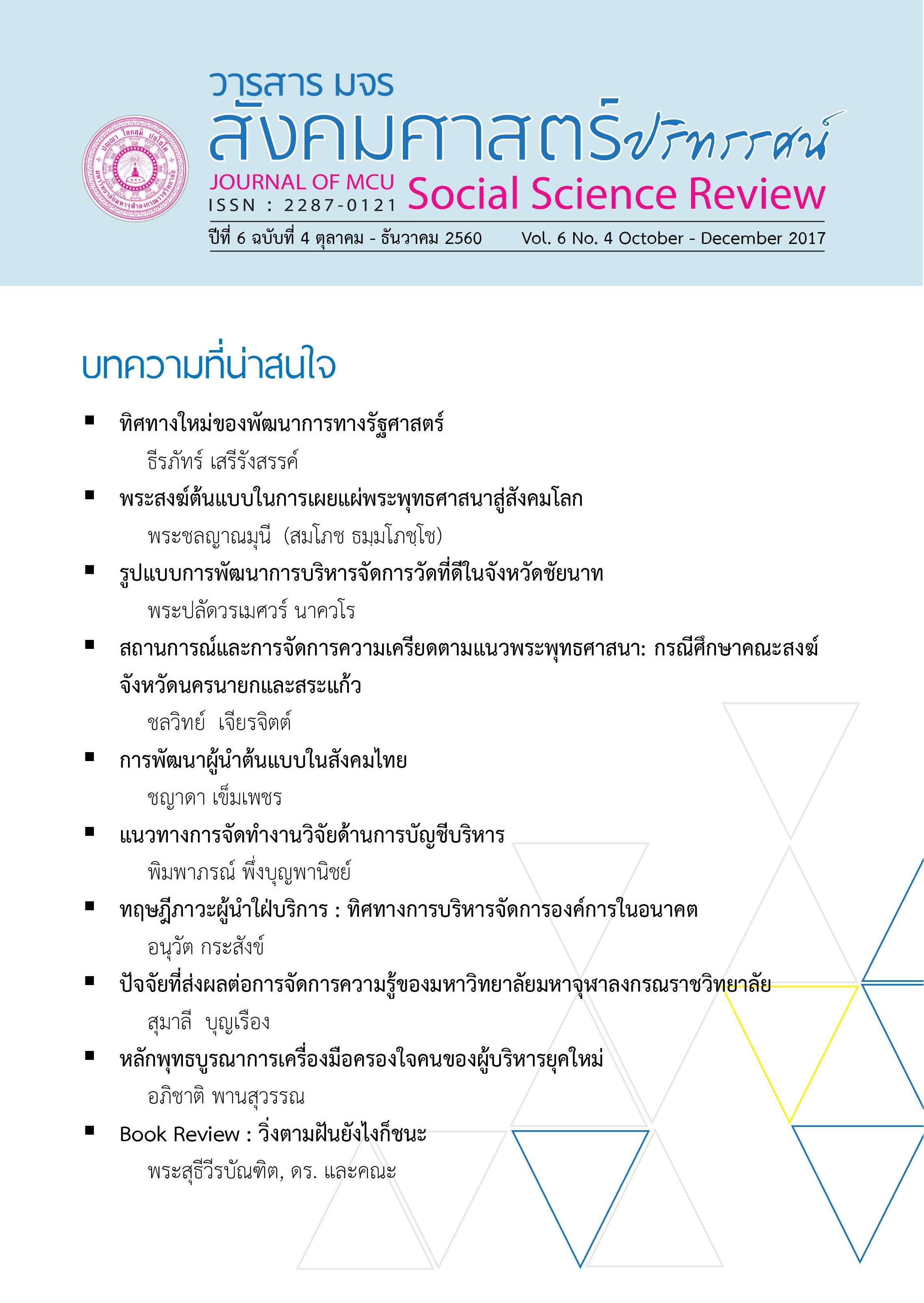ประสิทธิผลการปกครองของพระสังฆาธิการในเขตการปกครองคณะสงฆ์ ภาค 13
คำสำคัญ:
ประสิทธิผล, การปกครองของพระสังฆาธิการ, คณะสงฆ์ ภาค 13บทคัดย่อ
บทความวิจัยเรื่อง “ประสิทธิผลการปกครองของพระสังฆาธิการในเขตการปกครองคณะสงฆ์ภาค 13” มีวัตถุประสงค์ 1) เพื่อศึกษาสภาพการปกครองคณะสงฆ์ในเขตปกครองคณะสงฆ์ภาค 13 2) เพื่อนำเสนอประสิทธิผลการปกครองของพระสังฆาธิการในเขตการปกครองคณะสงฆ์ภาค 13 โดยใช้ระเบียบวิธีวิจัยแบบผสมผสานวิธี (Mixed Methods Research) ระหว่างการวิจัยเชิงคุณภาพ (Qualitative Research) ที่ใช้การสัมภาษณ์เชิงลึก (In-depth Interview) จากผู้ให้ข้อมูลสำคัญ 21 รูป/คน เพื่อหาการปกครองคณะสงฆ์เบื้องต้นก่อนนำเสนอต่อการสนทนากลุ่มเฉพาะ (Focus Group Discussion) และข้อมูลที่ได้ไปสู่การวิจัยเชิงปริมาณ (Quantitative Research) ที่ใช้การศึกษาวิจัยเชิงสำรวจ (Survey Research) จากกลุ่มตัวอย่าง 302 รูป โดยการสุ่มตัวอย่างแบบง่าย (Simple Random Sampling) เก็บรวบรวมข้อมูลโดยใช้แบบสอบถาม วิเคราะห์ข้อมูลด้วยสถิติพรรณนา ได้ค่าร้อยละ ค่าเฉลี่ยและค่าเบี่ยงเบนมาตรฐาน
ผลการวิจัยพบว่า
1. สภาพปัจจุบันประสิทธิผลการปกครองของพระสังฆาธิการในเขตการปกครอง คณะสงฆ์ภาค 13 พบว่า 1. ด้านดำเนินงานปกครองคณะสงฆ์ให้เป็นไปตามพระธรรมวินัย ให้พระภิกษุ ในสังกัดวัด ลงอุโบสถกรรมฟังพระปาฏิโมกข์ทุกกึ่งเดือนมีการเข้าร่วมประชุม
พระสังฆาธิการประจำเดือนที่ผู้บัญชาเหนือตนจัดประชุมให้พระภิกษุทำวัตรสวดมนต์เช้า-เย็นตลอดทั้งปีการให้คณะสงฆ์ห่มผ้าสีราชนิยมให้เหมือนกันและพร้อมเพรียงกันทั้งภาค 13 ห้ามพระสงฆ์ขับรถและมีเจ้าคณะปกครองสอดส่องดูแลอยู่เป็นประจำ 2. ด้านควบคุมและส่งเสริมการรักษาความสงบเรียบร้อยดีงามพบว่ามีการส่งเสริมการศาสนศึกษา การศึกษาสงเคราะห์ การเผยแผ่ การสาธารณูปการ การสาธารณสงเคราะห์การปกครองพระภิกษุสามเณรให้ปฏิบัติตามกฎระเบียบของวัดควบคุมดูแลพระภิกษุสามเณรให้ปฏิบัติตามพระธรรมวินัยจัดตั้งสำนักปฏิบัติธรรมประจำจังหวัดทำหน้าที่เพื่อประโยชน์ส่วนรวมไม่ใช่เพื่อตนเอง 3. ด้านระงับอธิกรณ์ พบว่า พระสังฆาธิการถือปฏิบัติในกฎระเบียบที่ไม่ขัดกับพระธรรมวินัย อย่างเคร่งครัดลงโทษพระภิกษุสามเณรภายใต้การปกครองโดยสมควรตามพระพุทธบัญญัติมีระเบียบ ในการลงโทษต่อภิกษุผู้ทุศีล 4. ด้านการแก้ไขข้อขัดข้องของเจ้าคณะปกครองให้เป็นไปโดยชอบ พบว่า พระสังฆาธิการให้มีการจัดทำบัญชีรับ-จ่าย อย่างเป็นระบบและโปร่งใสออกกฎระเบียบที่ไม่ขัดกับกฎหมายบ้านเมืองอย่างเคร่งครัดให้การช่วยเหลือเกื้อกูลการพัฒนาคุณภาพชีวิตของพุทธบริษัท 5. ด้านควบคุมการบังคับบัญชาเจ้าคณะปกครองพบว่าพระสังฆาธิการมอบหมายให้พระภิกษุสามเณร ทำวัตรเช้า - เย็น ตลอดทั้งปีมีการจัดทำทะเบียนประวัติพระภิกษุสามเณรที่อยู่ประจำวัดอย่างเป็นระบบสนับสนุนให้พระภิกษุเรียนปริยัติสามัญ-ปริยัติแผนกธรรม-แผนกบาลี โครงการหนึ่งมหาเปรียญหนึ่งอำเภอ 6. ด้านตรวจการและประชุมพระสังฆาธิการในเขตปกครองของตนพบว่า เมื่อมีกิจกรรม ในงานปกครองของวัดหรือทางคณะสงฆ์พระสังฆาธิการมีความยินดีเข้าร่วมกิจกรรมอยู่เสมอส่งเสริมพระภิกษุสามเณรออกไปปฏิบัติธรรมตามสมัยปีละ 2 ครั้งได้ดำเนินการประชุมให้ความรู้ในการบำเพ็ญกุศล ระหว่างคณะสงฆ์กับคฤหัสถ์ในปกครองอยู่เสมอห้ามพระถ่ายรูปสะพายกล้อง
2. ประสิทธิผลการปกครองของพระสังฆาธิการในเขตการปกครองคณะสงฆ์ภาค 13 พบว่า 1) หมั่นประชุมกันเนืองนิตย์ คือ ท่านได้ดำเนินการประชุมพระภิกษุสามเณรภายในพื้นที่ปกครองเป็นประจำ ท่านได้ดำเนินการประชุมระหว่างคณะสงฆ์กับชุมชนอยู่เนืองๆ 2) พร้อมเพรียงกันประชุม คือ การประชุมทุกคนต้องเคารพกฎระเบียบ มีมารยาทที่ดีในการประชุม เคารพประธานในการประชุม 3) ไม่บัญญัติสิ่งที่พระพุทธเจ้าไม่ทรงบัญญัติคือผู้ปกครองคณะสงฆ์ควรจะปฏิบัติตามหลักพระธรรมวินัย และกฎหมายของบ้านเมือง เอื้อเฟื้อต่อพระธรรมวินัย 4) ภิกษุเหล่าใดเป็นผู้ใหญ่เคารพนับถือภิกษุเหล่านั้น คือ ควรจัดให้มีกิจกรรมอบรมหรือสัมมนาแก่พระภิกษุใหม่อย่างน้อยเดือนละครั้ง เพื่อให้พระภิกษุใหม่ได้พบปะเจ้าคณะปกครองและเพื่อนสหธรรมิกต่างวัดมากขึ้น 5) การไม่ลุอำนาจตัณหาความอยากที่เกิดขึ้น คือ การเสียสละก็ดี การมีใจเมตตาปราณีกับผู้อื่นก็ดี เป็นคุณธรรมที่จะช่วยปิดกั้นความลุอำนาจตัณหาที่จะเกิดขึ้นในจิตได้ 6) การยินดีในเสนาสนะป่า คือ ควรดูแลเสนาสนะที่อยู่อาศัยให้สะอาดเรียบร้อยปลอดภัย เป็นสาเหตุให้เกิดความสงัด เกิดความสงบ ไม่พลุกพล่านจนเกินไป ให้เกิดระเบียบปฏิบัติอย่างเคร่งครัด 7) สพรหมจารีผู้มีศีลดีงามยังไม่มาขอให้มา คือ ควรมีนโยบายเข้มงวด เพื่อนำมาใช้ในการบริหารจัดการวัด โดยนำเอาเทคโนโลยีสมัยใหม่มาใช้ในการพัฒนาวัดให้มากขึ้น
เอกสารอ้างอิง
Creswell, J. W. (2007). Qualitative Inquiry and Research Design: Choosing among Five Traditions.
Janyasupab P. (2000). The Development of Economic Optimum Size Determination Models for Secondary School (Doctoral Dissertation). Faculty of Education: Chulalongkorn University.
Mahachulalongkornrajavidyalaya University. (2008). Kān Pokkhrō̜ng Khana Song Thai [The Administration of Thai Buddhist Sangha]. Bangkok: Mahachulalongkorn-
rajavitayala Printing House.
Panich A. (2007). The Organization Effectiveness Factors of Rajabhat Universities (Doctoral Dissertation). Department of Educational Administration. Graduate School: Sipakorn University.
Phrakru Uthaikitphiphat (Wirut Suk-in). (2011). Leadership Applying the Seven Sappurisadhammas of Buddhist Ecclesiastical Officials in Uthai Thani Province (Master’s Thesis). Graduate School: Mahachulalongkornrajavidyalaya University.
Phrommeenate P. (2009). The Form of Educational Leadership Development According to Buddhadhamma (Doctoral Dissertation). Graduate School: Naresuan University.
Religious Affairs. Department. (1997). Khūmu Phra Sangkhāthikān Wādūai Kān Khana Song Læ Kān Phrasātsanā [Guideline for Buddhist Ecclesiastical Official Monk about Buddhist Sangha and Activites]. Bangkok: Religious Affairs Printing House.
Silverman. D. (2000). Doing Qualitative Research: A Practical Handbook. London: Sange.
Strauss. A. and J. Corbin. (1990). Basics of Qualitative Research: Grounded Theory Procedures and Techniques. Newbury Park. California. Sage.
Yamane. Taro. (1967). Statistics: An Introductory Analysis. New York: Harpen and Row.
ดาวน์โหลด
รูปแบบการอ้างอิง
ฉบับ
ประเภทบทความ
สัญญาอนุญาต
ลิขสิทธิ์ (c) 2017 วารสาร มจร สังคมศาสตร์ปริทรรศน์

อนุญาตภายใต้เงื่อนไข Creative Commons Attribution-NonCommercial-NoDerivatives 4.0 International License.
เพื่อให้เป็นไปตามกฎหมายลิขสิทธิ์ ผู้นิพนธ์ทุกท่านต้องลงลายมือชื่อในแบบฟอร์มใบมอบลิขสิทธิ์บทความให้แก่วารสารฯ พร้อมกับบทความต้นฉบับที่ได้แก้ไขครั้งสุดท้าย นอกจากนี้ ผู้นิพนธ์ทุกท่านต้องยืนยันว่าบทความต้นฉบับที่ส่งมาตีพิมพ์นั้น ได้ส่งมาตีพิมพ์เฉพาะในวารสาร มจร สังคมศาสตร์ปริทรรศน์ เพียงแห่งเดียวเท่านั้น หากมีการใช้ภาพหรือตารางหรือเนื้อหาอื่นๆ ของผู้นิพนธ์อื่นที่ปรากฏในสิ่งตีพิมพ์อื่นมาแล้ว ผู้นิพนธ์ต้องขออนุญาตเจ้าของลิขสิทธิ์ก่อน พร้อมทั้งแสดงหนังสือที่ได้รับการยินยอมต่อบรรณาธิการ ก่อนที่บทความจะได้รับการตีพิมพ์ หากไม่เป็นไปตามข้อกำหนดเบื้องต้น ทางวารสารจะถอดบทความของท่านออกโดยไม่มีข้อยกเว้นใดๆ ทั้งสิ้น





